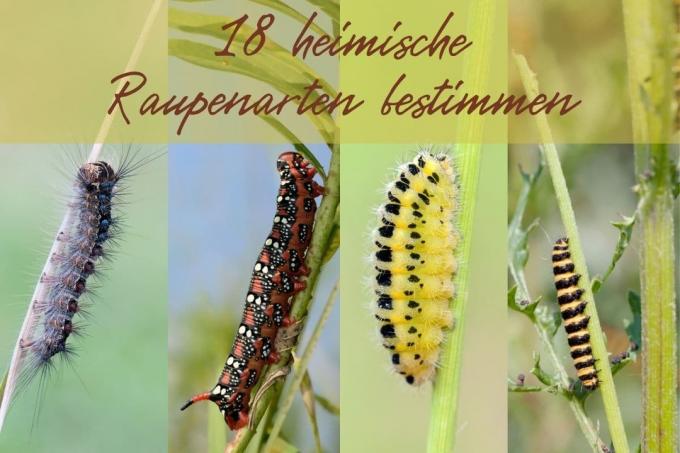
table of contents
- Caterpillars determine by color
- Protection against predators
- Well camouflaged caterpillar species
- Green caterpillars
- Brown caterpillar species
- Deterrent colored caterpillars
- Caterpillars with black-yellow coloring
- More conspicuously colored caterpillars
- Very hairy caterpillar species
- frequently asked Questions
As different as the individual butterflies look, so are their caterpillars. From green to black to brightly patterned, from smooth to thorny to hairy, everything is included. With the help of the following article, you can easily identify some caterpillars.
In a nutshell
- Caterpillars are a larval stage of butterflies
- the larvae of some plant wasps and beaked flies also resemble caterpillars
- the body of the caterpillar consists of 14 segments in a row
- these are divided into head, chest and abdomen
- Characteristic for a caterpillar species is, among other things, the color and hairiness
Caterpillars determine by color
Unfortunately, you can hardly draw any conclusions from the appearance of the caterpillar about the adult butterfly. As a rule, the larval stages look completely different from the moths. If they do not have distinctive features, they are difficult to determine. However, if you look at the fodder plant, on which the caterpillar feeds, in addition to the color and hairiness, you often come a good step closer to the solution of the riddle.
Protection against predators
In general, the caterpillars have two different tactics to protect themselves from their enemies. While some try not to attract attention, others rely on deterrence.
Well camouflaged caterpillar species
Some species of caterpillars camouflage themselves by adopting the color and pattern of their forage plants.
Green caterpillars
Greenish colored butterfly caterpillars blend perfectly with the leaves and are therefore not so easy to spot. The native green caterpillar species include:
Evening peacock butterfly (Smerinthus ocellata)

- Moth of the hawkmoth family (Sphingidae)
- maximum body length: up to 80 mm
- Caterpillar season: usually one generation from June to September, rarely two generations
- Food: willows, poplars, birches, apple trees
- Basic color: blue-green, rarely yellow-green with yellow side stripes diagonally upwards from below
- special features: fine white dots all over the body, light blue anal horn
- Hairiness: no
Little Frostworm (Operophtera brumata)
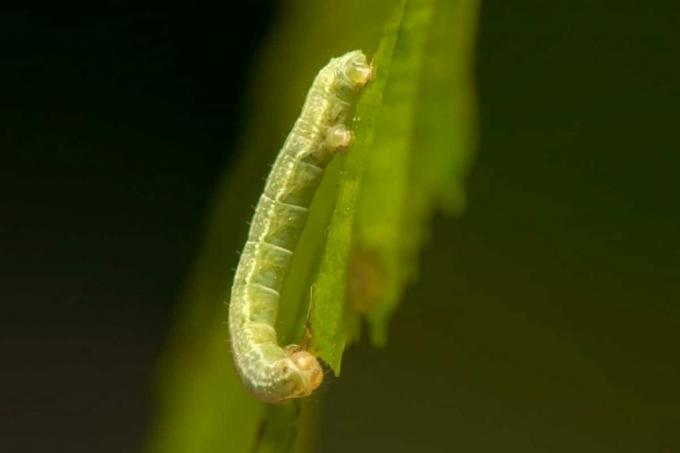
- Butterfly of the Spanner family (Geometridae)
- maximum body length: up to 25 mm
- Caterpillar season: one generation between March and June
- Host plants: fruit trees, oak, beech, maple
- special features: have only one pair of belly feet
- Caterpillars in a fine web between the leaves
- Hairiness: no
Checkerboard Butterfly (Melanargia galathea)
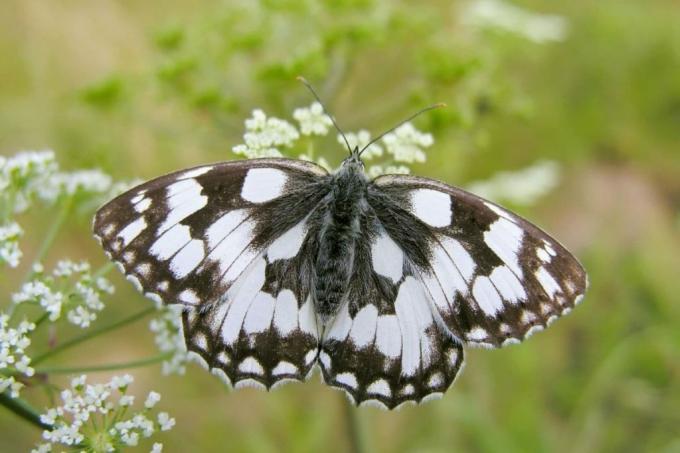
- Butterflies from the subfamily of the eye butterflies (Nymphalidae)
- maximum body length: 28 mm
- Caterpillar season: July / August
- Food: grasses such as fescue and meadow bluegrass
- special characteristics: green or yellow-brown color, light brown head
- Hairiness: dense but very short hairs
Pigeon tail (Macroglossum stellatarum)

- Moth of the hawkmoth family (Sphingidae)
- maximum body length: 40 to 50 mm
- Host plants: preferably bedstraws (Galium) such as meadow bedstraw
- light green with two whitish lines from head to abdomen, black dots at regular intervals
- special features: bluish anal horn with yellow tip, red belly and chest feet
- Hairiness: no
Tip: Moth caterpillars from the hawkmoth family have a noticeable sting on their abdomen: a so-called anal horn.
Brimstone Butterfly (Gonepteryx rhamni)
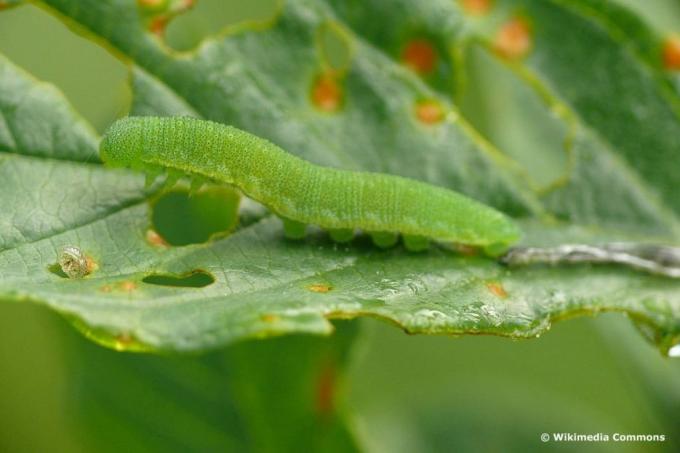
- Butterflies from the family of the whiteflies (Pieridae)
- Body length: around 30 mm
- Caterpillar season: usually one generation (June / July), sometimes several (until October)
- Host plants: buckthorn and buckthorn
- Basic color: matt green
- special characteristics: white vertical stripes above the legs
- Hairiness: no
Brown caterpillar species
Not only green, but also brown is a perfect camouflage color in nature. To recognize these caterpillars in the garden or forest is not that easy. Because they don't move, they look like a dried up twig or look like leaves.
Broad-winged gang owl (Noctua comes)
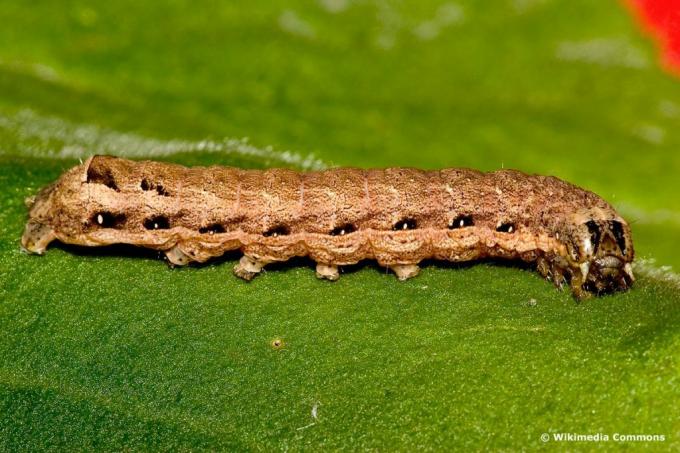
- Moth of the family of the owl butterflies (Noctuidae)
- maximum body length: 60 mm
- Caterpillar season: one generation between autumn and mid-May
- Host plant: various flowers and herbs, berry bushes, sour cherries
- Color: reddish gray to greenish brown
- special features: large dark brown triangular spots on the side and the back
- Hairiness: no
Beech tooth moth (Stauropus fagi)

- Moth of the tooth moth family (Notodontidae)
- maximum length: 60 mm
- Caterpillar season: 2 generations (April / May and June / August)
- Host plants: beech, English oak, hawthorn, dogwood and field maple
- Special characteristics: forelegs greatly elongated, rear segments fused together like scales
- act like primeval mini dragons
- Hairiness: none
Hawthorn Owl (Allophyes oxyacanthae)
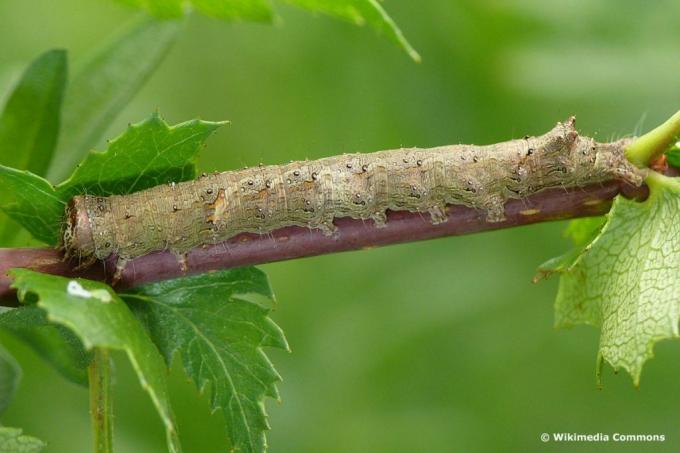
- Butterfly from the family of the owl butterflies (Noctuidae)
- maximum body length: 50 to 60 mm
- Caterpillar season: one generation in July / August
- Forage plants: sloes, hawthorn
- Basic color: various brownish-gray tones with many dark lines
- special features: small black-brown warts on the back
- Hairiness: only a few short hairs
Deterrent colored caterpillars
The second way to avoid being eaten is particularly noticeable colors. With these signal colors they show their predators that they are poisonous. While some species of caterpillars are able to produce a poison themselves, others ingest it through their forage plants.
Caterpillars with black-yellow coloring
The combination of black and yellow often imitates the appearance of other insects such as wasps, which are only found on the menu of a few bird species. Otherwise, the yellow color has a signaling effect that suggests that the potential meal is poisonous.
Great Cabbage White butterfly (Pieris brassicae)
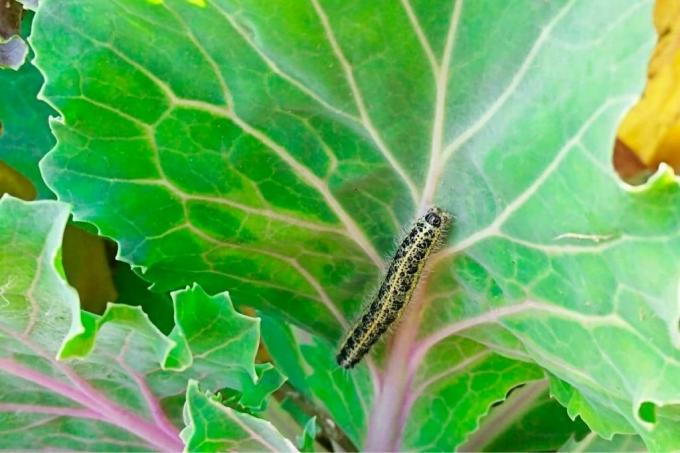
- Butterflies from the family of the whiteflies (Pieridae)
- maximum length: 40 mm
- Caterpillar season: two to three generations from March to October
- Forage plant: cabbage species and cruciferous plants
- Color: yellowish-green and spotted black
- store toxic sulfur compounds from food
- special characteristics: young caterpillars usually gregarious in groups
- Hair: fine white hairs (relatively short)
Jacob wort bear (Tyria jacobaeae)
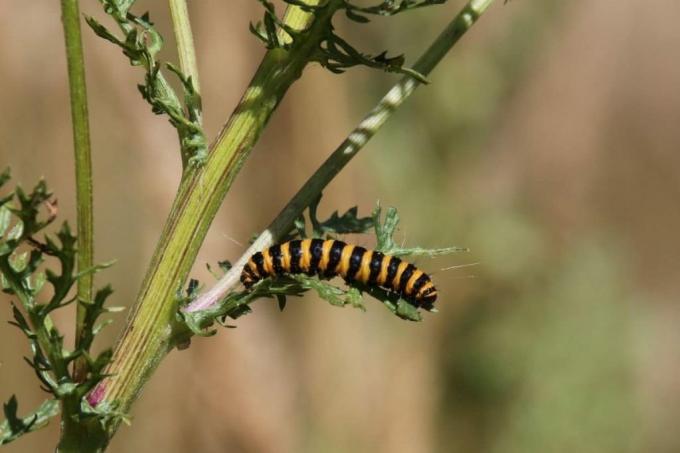
- Moth from the subfamily of the bear moth (Arctiinae)
- maximum body length: 30 mm
- Host plants: Jacob's ragwort
- stores poisonous alkaloids from food in the body
- special features: conspicuous yellow-black ringed body
- Hairiness: single long white and short black hairs
Small tortoiseshell (Aglais urticae)

- Butterfly of the noble butterfly family (Nymphalidae)
- maximum body length: 30 mm
- Caterpillar season: 2 to 3 generations (June to October)
- Host plants: mainly nettles
- Basic color: black with two interrupted yellow side lines
- Special features: clearly separated black head in young caterpillars, form webs
- Hairiness: spines on the sides and back
Moon spot or moon bird (Phalera bucephala)

- Moth of the tooth moth family (Notodontidae)
- maximum body length: 60 mm
- Caterpillar season: July to August
- Forage plant: many different types of trees and shrubs
- Color: black with orange-yellow horizontal stripes and yellow-white vertical stripes
- special features: black head with yellow V
- Hairiness: fine, white bristles
Six-spot ram (Zygaena filipendulae)

- Moth of the ram family (Zygaenidae)
- maximum length: 22 mm
- Caterpillar season: one generation between August and October
- Forage plant: Horn clover, Kronwicken
- Appearance: green-yellow basic color with a double row of black spots
- special features: black head capsule
- Hairiness: fine, short bristles
More conspicuously colored caterpillars
Middle Wine Hawk (Deilephila elpenor)
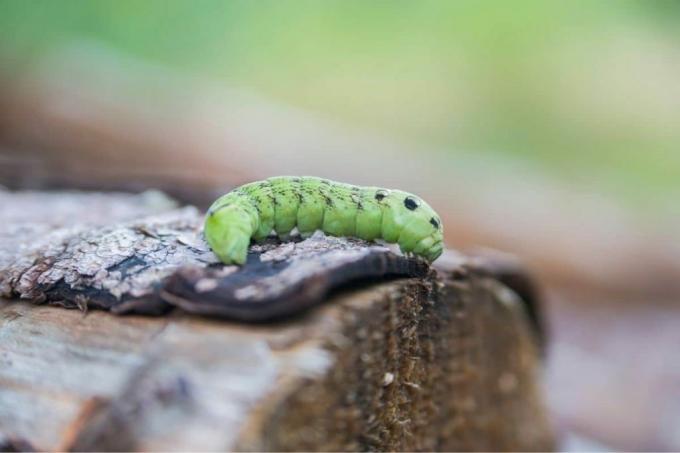
- Moth of the hawkmoth family (Sphingidae)
- maximum length: 50 to 80 mm
- Caterpillar season: one generation (June to August)
- Host plant: balsam, fireweed, fuchsias, Evening primrose
- Color: initially greenish, later brownish to almost black
- Special features: two conspicuous eye spots on each side of the abdomen segment (imitation of a snake)
- Hairiness: no
Swallowtail (Papilio machaon)
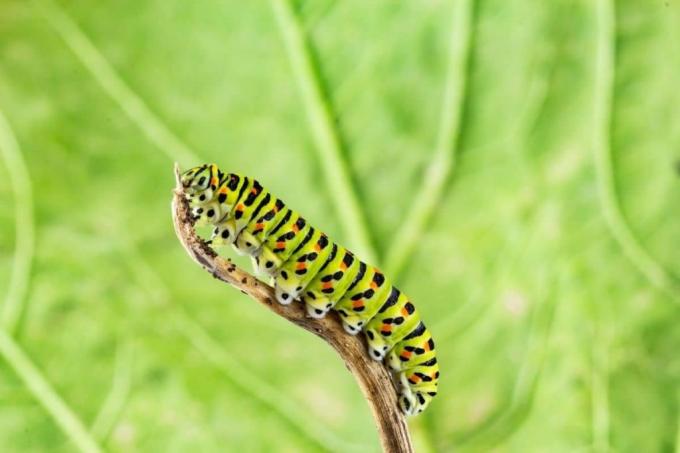
- Butterfly from the family of the knightly butterflies (Papilionidae)
- maximum body length: 45 mm
- Caterpillar season: 1 to 3 generations (May to August)
- Host plants: Umbelliferae such as dill, fennel and carrots
- special features: mint green base color, black and yellow spotted stripes
- Hairiness: none
Note: When in danger, the swallowtail caterpillars release a scent that drives away predators and ants.
Spurge Hawk (Hyles euphorbiae)
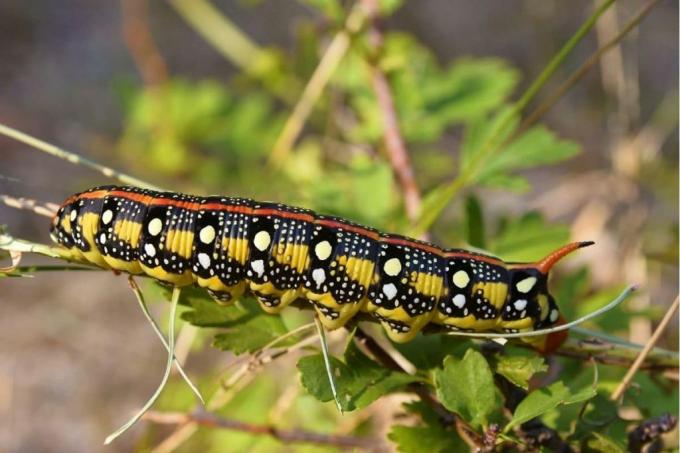
- Moth of the hawkmoth family (Sphingidae)
- maximum length: 70 to 80 mm
- Caterpillar time: a generation of
- Forage plants: cypress milkweed
- Caterpillars drink the plant's poisonous sap
- Appearance: very variable, but always black with red, white and yellow areas
- special features: head, legs and anal horn are always colored red
- Hairiness: none
Very hairy caterpillar species
The caterpillars of some species of butterflies have a completely different tactic to protect themselves from predators. You have stinging hair. These stinging hairs are equipped with barbs or an active ingredient that causes a stinging sensation when touched, as we know it from stinging nettles, for example.
Gypsy moth (Lymantria dispar)
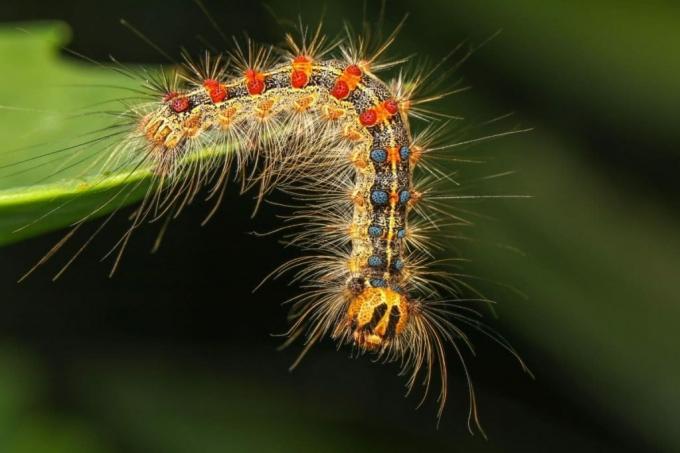
- maximum body length: 40 to 70 mm
- Caterpillar season: one generation (April to June)
- Appearance: gray to gray-yellow, finely dotted
- Special characteristics: blue warts in two rows in the neck area, red warts up to the abdomen
- Host plants: beeches, oaks, chestnuts, fruit trees
Oak processionary moth (Thaumetopoea processionea)
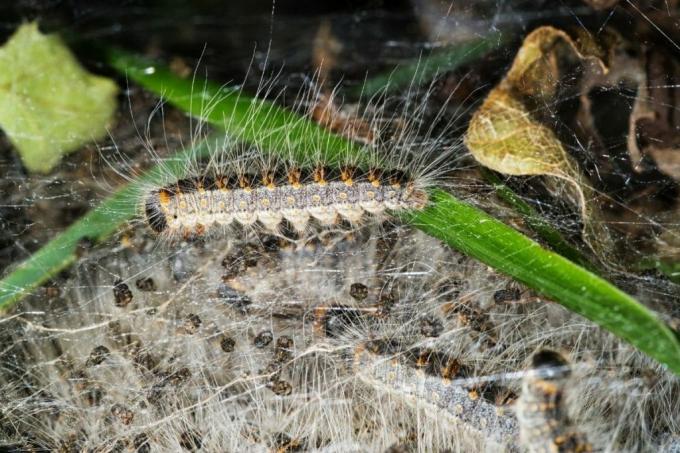
- maximum length: up to 40 mm
- Caterpillar season: early May to June
- Appearance: bluish black, sometimes brown in color with very long white hair
- Host plant: all types of oak
- Young caterpillars form webs in forks of branches and on trunks
frequently asked Questions
In contrast to conspicuously colored caterpillars, green and brown caterpillars protect themselves by merging with their subsurface and thus being almost invisible. Most species are naturally non-toxic. However, a few species feed on plants with toxic ingredients, making them poisonous to their predators.
The caterpillar season starts in Germany in May. Depending on how many generations the butterfly forms in a year, you can find it until the beginning of October. A few species like the frost wrench are also active earlier.
Most native butterfly species do not overwinter as a butterfly, but as an egg, caterpillar or pupa. Therefore, it is not uncommon to encounter a (inactive) caterpillar even in winter. However, this is then usually frozen in time.
